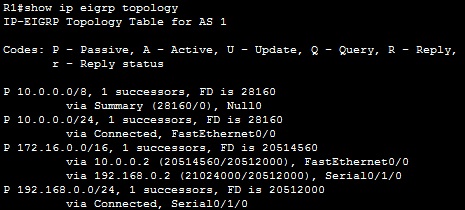EIGRP tables
Each EIGRP router uses three to store routing information:
- Neighbor table – stores information about EIGRP neighbors. Before exchanging routes, routers need to establish a neighbor relationship. Information such as the IP address of the neighbor, the local interface on which the Hellos were received, the holddown timer, and Smooth round-trip time are kept in this table.
- Topology table – stores routing information learned from neighbor routing tables. This table stores every EIGRP route inside the autonomous system. The topology table also holds the metrics for each of the listed EIGRP routes, the feasible successor and the successors.
- Routing table – stores only the best routes to reach a remote network.
Consider the following example network:
We have a network of three routers, all running EIGRP. The routers have established neighbor relationships and the routes have been exchanged. Let’s display the neighbor table on R1 using the show ip eigrp neighbors command:
You can see that R1 has established two neighbor relationships. The information such as the neighbor’s IP address, the local interface, the holddown timer, are displayed.
Now let’s display the topology table on R1 using the show ip eigrp topology command:
We will explain the concept of successor and feasible successor in the next sections. For now, just remember that this table contains all routes learned by EIGRP. Notice how there are two possible routes to the 172.16.0.0/16 network, one via 10.0.0.2 and the other via 192.168.0.2.
The routing table looks like this:
Note that there is only one route to the 172.16.0.0/16 network – the best route, via 10.0.0.2.







